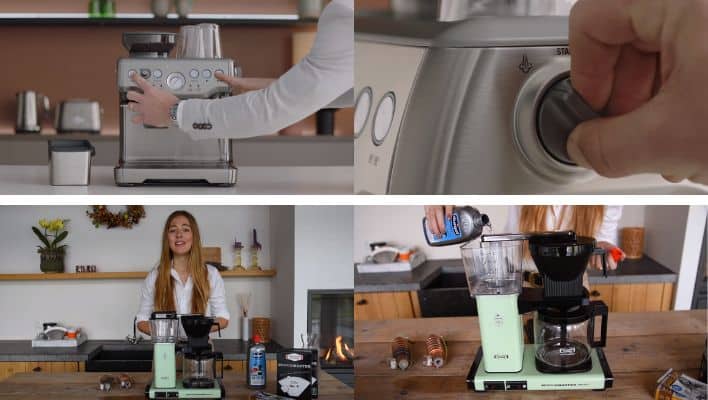Regular cleaning and descaling of your coffee maker is essential for optimal performance and to prevent the build-up of mineral deposits. Neglecting this maintenance can result in a bitter taste and slower brewing times.
Keep your coffee maker clean and efficient by following these simple steps.

Why Coffee Maker Cleaning And Descaling Is Essential
The Importance Of Regular Cleaning And Descaling
Cleaning and descaling your coffee maker regularly is not just a matter of personal hygiene, but it also plays a crucial role in enhancing the taste and quality of your coffee. Neglecting this essential task can lead to a buildup of mineral deposits, coffee residue, and bacteria, all of which can have a detrimental impact on your coffee experience.
Furthermore, regular cleaning and descaling ensure the longevity of your coffee maker, preventing issues that may arise from clogged or damaged components. Let’s delve deeper into why coffee maker cleaning and descaling is absolutely essential.
Impact On The Taste And Quality Of Your Coffee:
Maintaining a clean coffee maker is directly correlated to the taste and quality of the coffee it brews. Here’s why:
- Freshness: Residual coffee oils and mineral deposits can accumulate over time, resulting in a stale taste and diminishing the aromatic profile of your coffee.
- Consistency: A dirty coffee maker can introduce undesirable flavors and notes into your brew, leading to an inconsistent taste experience.
- Bitterness: The buildup of mineral deposits in your coffee maker can contribute to the bitterness of your coffee, overpowering the desirable flavors and leaving an unpleasant aftertaste.
- Smoothness: By regularly cleaning and descaling your coffee maker, you can ensure a smoother and more enjoyable cup of coffee, free from any unwanted residues.
Ensuring The Longevity Of Your Coffee Maker:
Regular cleaning and descaling of your coffee maker not only improve the taste and quality of your coffee but also ensure the longevity of your beloved appliance. Here’s how:
- Efficiency: Mineral deposits, if left unchecked, can clog the internal components of your coffee maker, causing it to work harder, consume more energy, and potentially shorten its lifespan.
- Preventing breakdowns: The accumulation of coffee oils and residue can lead to clogs and blockages, impairing the functioning of your coffee maker and increasing the risk of breakdowns.
- Hygiene: Neglecting cleaning and descaling can create a breeding ground for bacteria, mold, and other contaminants, compromising the cleanliness and safety of your coffee maker.
By committing to regular cleaning and descaling, you can ensure that your coffee maker continues to work optimally, providing you with consistent and delicious cups of coffee for years to come. So, prioritize this simple yet vital task, and you’ll reap the rewards of a well-maintained coffee maker and an exceptional coffee experience.
Signs That Your Coffee Maker Needs Cleaning And Descaling
Flavor changes in your coffee:
- One of the first signs that your coffee maker needs cleaning and descaling is a noticeable change in the flavor of your brewed coffee. If you start to notice that your coffee tastes dull, bitter, or off, it’s likely due to mineral buildup and residue in your coffee maker. Cleaning and descaling your machine can help restore the richness and smoothness of your coffee’s flavor.
Longer brew time:
- Another indication that your coffee maker is in need of cleaning and descaling is a longer brew time. If you notice that it takes longer than usual for your coffee to brew, it could be a sign of clogged or partially blocked water lines. Mineral deposits can accumulate over time and obstruct the flow of water in your coffee maker, leading to slower brewing times. Regular cleaning and descaling can help maintain optimal performance and ensure a quick and efficient brewing process.
Visible mineral deposits:
- One of the most obvious signs that your coffee maker is due for a cleaning and descaling is the presence of visible mineral deposits. If you notice white or brownish buildup on the internal components of your machine, such as the water reservoir, spray head, or coffee pot, it’s a clear indication that minerals from the water have built up over time. These deposits can affect the taste of your coffee and hinder the proper functioning of your coffee maker. Cleaning and descaling will remove these unsightly deposits and restore your machine to its original condition.
Unpleasant odor:
- If you detect an unpleasant odor coming from your coffee maker, it’s a strong indication that cleaning and descaling are necessary. Over time, bacteria and mold can accumulate in the moist environment of your machine, resulting in a foul smell. Additionally, mineral deposits can contribute to a musty or metallic odor in your coffee maker. Regular cleaning and descaling will not only eliminate these odors but also ensure that your coffee is brewed in a clean and hygienic environment.
Remember, keeping your coffee maker clean and descaled is essential for maintaining the quality of your coffee and the performance of your machine. By paying attention to these signs and regularly performing cleaning and descaling, you can enjoy a delicious cup of coffee every time you brew.
The Step-By-Step Guide To Cleaning Your Coffee Maker
Coffee Maker Cleaning And Descaling
If you’re a coffee lover, you know how important it is to keep your coffee maker clean and free of mineral deposits. Not only does regular cleaning and descaling improve the taste of your coffee, but it also helps prolong the life of your machine.
In this step-by-step guide, we’ll walk you through the process of cleaning your coffee maker, ensuring that your morning cup of joe is always brewed to perfection. Let’s dive in!
Gather The Necessary Supplies
Before you begin cleaning your coffee maker, gather the following supplies:
- White vinegar
- Water
- Dish soap
- Soft cloth or sponge
- Toothbrush (optional)
Empty And Rinse The Carafe And Filter Basket
Start by emptying any leftover coffee from the carafe and removing the filter basket. Give both the carafe and filter basket a thorough rinse with warm, soapy water. Use a soft cloth or sponge to wipe away any coffee stains or residue.
Clean The Exterior Of The Coffee Maker
Next, focus on cleaning the exterior of your coffee maker. Simply dampen a cloth with warm, soapy water and gently wipe down the surface. Pay attention to any stubborn stains or spills, using a toothbrush if necessary for hard-to-reach areas.
Clean The Water Reservoir And Filter Holder
To clean the water reservoir, fill it with equal parts white vinegar and water. Let the mixture sit for about 15 minutes to dissolve any mineral buildup. Afterward, empty the reservoir and give it a thorough rinse with fresh water.
As for the filter holder, remove any coffee grounds or filters and wash it with warm, soapy water. Use a toothbrush to scrub away any residue or stains, ensuring it’s completely clean before reassembling.
Run A Cleaning Cycle With A Vinegar Solution
Now it’s time to clean the internal components of your coffee maker. Fill the water reservoir with a mixture of one part white vinegar to two parts water. Place the carafe back onto the machine and start the brewing cycle.
Allow the vinegar solution to run through the machine entirely.
Rinse The Coffee Maker Thoroughly
After running the vinegar solution, refill the water reservoir with fresh water and run another brewing cycle. This will rinse out any remaining vinegar from the internal parts. Repeat this process at least twice to ensure a complete rinse.
By following these simple steps, you can effectively clean and descale your coffee maker, keeping it in top shape for brewing your favorite cup of coffee. Remember to perform this cleaning routine regularly to maintain the taste and performance of your machine.
Happy brewing!
The Importance Of Descaling Your Coffee Maker Regularly
Coffee is a beloved morning ritual for many, and a good cup of java can make all the difference in starting your day on the right foot. However, have you ever noticed that over time your coffee maker doesn’t produce the same flavorful brew as it once did?
It may be time to give your trusty appliance some much-needed attention. Descaling your coffee maker regularly is an essential maintenance task that ensures your machine continues to work efficiently and brews the perfect cup every time.
Understanding Limescale Buildup
Limescale buildup is a common issue that affects coffee makers. It occurs when minerals, primarily calcium and magnesium, present in your water accumulate over time and form a hard, chalky substance. This buildup not only affects the taste of your coffee but also hampers the performance of your coffee maker.
It can clog the internal components, such as the heating element and water hoses, leading to reduced water flow and less efficient brewing.
Effects Of Limescale On Your Coffee Maker
Neglecting to descale your coffee maker can have several detrimental effects on its performance and lifespan. Here are some key points to consider:
- Reduced brewing temperature: Limescale buildup insulates the heating element, preventing it from reaching its optimal temperature. As a result, your coffee might taste weak or lack its usual boldness.
- Increased brewing time: The restricted water flow caused by limescale can slow down the brewing process, making it take longer for your coffee to be ready.
- Clogged water lines: Over time, limescale deposits can accumulate in the water lines, causing blockages and potential leaks.
- Malfunctioning parts: Limescale can damage the sensitive components of your coffee maker, such as valves and pumps, leading to expensive repairs or even the need for a replacement.
Different Descaling Methods And Products
Thankfully, descaling your coffee maker is a relatively simple process that doesn’t require much effort. Here are a few effective methods and products to consider:
- Vinegar: A widely available and cost-effective option, vinegar is excellent for removing limescale. Mix equal parts water and white vinegar, run the solution through your coffee maker, followed by a few cycles of clean water to rinse.
- Lemon juice: If you prefer a natural alternative, lemon juice works well as a descaler due to its citric acid content. Follow a similar process as with vinegar but replace it with equal parts lemon juice and water.
- Descaling solution: Specialty descaling solutions are designed specifically for coffee makers. They are formulated to effectively remove limescale buildup without causing damage. Consult your coffee maker’s user manual to find an appropriate descaling solution and follow the instructions provided.
Keeping your coffee maker clean and descaled is crucial to maintaining its functionality and ensuring that each cup of coffee is as delicious as the first. Make it a regular part of your cleaning routine, and you’ll reap the rewards of a consistently great-tasting brew.
How To Descale Your Coffee Maker Effectively
Coffee makers are a staple in many households, but over time, mineral deposits from the water can build up and hinder their performance. Descaling your coffee maker regularly is essential to maintain its efficiency and prolong its lifespan. In this section, we will discuss the steps to effectively descale your coffee maker, ensuring that you can continue to enjoy a delicious cup of joe every morning.
Choosing The Right Descaling Solution
To effectively descale your coffee maker, it is crucial to use the right descaling solution. There are various options available, but the two most common and effective solutions are a mixture of equal parts water and white vinegar or commercial descaling products.
Consider the following factors when choosing a descaling solution:
- Compatibility: Check your coffee maker’s manual for any specific recommendations regarding descaling solutions.
- Convenience: Commercial descaling products often come in pre-measured packets for convenience, while the vinegar-water mixture is a cost-effective and easily accessible option.
Preparing The Coffee Maker For Descaling
Before starting the descaling process, it is important to prepare your coffee maker properly. Follow these steps:
- Empty the coffee maker: Remove any remaining coffee grounds or filters and discard them. Make sure the coffee maker is empty and free of debris.
- Wipe down the exterior: Use a damp cloth to wipe down the outside of the coffee maker, removing any dust or grime that may have accumulated.
Running A Descaling Cycle
Now that your coffee maker is prepped, it’s time to run a descaling cycle. Here’s how:
- Fill the water reservoir: Fill the water reservoir with the descaling solution according to the manufacturer’s instructions or the recommended ratio (if using a vinegar-water mixture).
- Start the cycle: Turn on the coffee maker and allow the descaling solution to run through the machine as if you were brewing a pot of coffee. Make sure to place a container to catch the liquid.
- Pause halfway through: Once the cycle is halfway through, pause the coffee maker and let the solution sit for about 15-30 minutes. This allows the descaling solution to break down any mineral deposits effectively.
- Complete the cycle: After the designated time, resume the descaling cycle and let it finish. Dispose of the liquid in the container.
Rinse And Clean The Coffee Maker After Descaling
After completing the descaling cycle, it is essential to rinse and clean your coffee maker thoroughly. Follow these steps:
- Run multiple rinse cycles: Fill the water reservoir with clean water and run a few cycles without adding coffee grounds to rinse out any remaining descaling solution.
- Clean removable parts: Remove and clean any removable parts, such as the filter basket and carafe, with warm, soapy water. Rinse them thoroughly before reassembling.
- Wipe down and dry: Using a clean cloth or paper towel, wipe down the exterior of the coffee maker to remove any residue. Ensure that all components are completely dry before using the coffee maker again.
By following these steps, you can effectively descale your coffee maker, keeping it in optimal condition and ensuring a consistently delicious cup of coffee. Remember to refer to your specific coffee maker’s manual for any additional instructions or recommendations. Cheers to a well-maintained coffee maker and a flavorful brew!
Additional Tips For Maintaining Your Coffee Maker
Keeping your coffee maker clean and well-maintained is essential for ensuring that you always have a delicious cup of coffee. Alongside regular cleaning and descaling, there are a few additional tips that can help prolong the life of your coffee maker and maintain its performance.
Let’s take a closer look at these tips:
- Use filtered water for brewing: Using filtered water has several benefits when it comes to maintaining your coffee maker. It helps to reduce the mineral buildup in the machine, which can affect the taste and performance of your coffee maker. Opting for filtered water also helps in preventing clogs and extends the lifespan of your coffee maker.
- Clean or replace the water filter regularly: If your coffee maker has a built-in water filter, make sure to clean or replace it regularly. Over time, the filter can become clogged with impurities, affecting the quality of your coffee. Refer to the manufacturer’s instructions for guidance on how often to clean or replace the filter.
- Store the coffee maker properly when not in use: Proper storage of your coffee maker when it’s not in use is crucial for maintaining its functionality. Avoid leaving it out on the countertop where it can accumulate dust and debris. Instead, store it in a clean, dry place to prevent any potential damage.
- Regularly deep clean and descale your coffee maker: Alongside routine cleaning, it’s important to deep clean and descale your coffee maker periodically. This process helps remove mineral deposits and buildup that can affect the taste and performance of your coffee. Follow the manufacturer’s instructions on how to descale your specific coffee maker model.
By following these additional tips for maintaining your coffee maker, you can ensure that it continues to produce great-tasting coffee cup after cup. Remember, a clean and well-maintained coffee maker is the key to brewing the perfect cup of joe every time.
Frequently Asked Questions For Coffee Maker Cleaning And Descaling
How Often Should I Clean My Coffee Maker?
It is recommended to clean your coffee maker every month to ensure the best taste and performance.
What Is The Difference Between Cleaning And Descaling A Coffee Maker?
Cleaning a coffee maker involves removing coffee residue and oils, while descaling focuses on removing mineral buildup caused by hard water.
Can I Use Vinegar To Clean And Descale My Coffee Maker?
Yes, vinegar is a cost-effective and natural option for cleaning and descaling your coffee maker.
How Do I Clean The Water Reservoir Of My Coffee Maker?
To clean the water reservoir, gently scrub it with a mixture of warm water and mild dish soap, then rinse thoroughly.
Are There Any Cleaning Solutions Specifically Designed For Coffee Makers?
Yes, there are cleaning solutions available in the market that are designed to effectively clean and descale coffee makers.
Conclusion
After reading this comprehensive guide on coffee maker cleaning and descaling, you are now equipped with the knowledge and techniques to keep your beloved coffee maker running smoothly. Regular cleaning and descaling are essential to prolong the lifespan of your machine, ensure the best-tasting coffee, and prevent mineral buildup that can affect its performance.
By following the step-by-step instructions and utilizing natural cleaning solutions, you can easily maintain a clean and efficient coffee maker. Remember to always consult your machine’s manual for specific cleaning instructions. With just a little effort and consistency, you can enjoy a delicious cup of coffee every time.
So, roll up your sleeves and give your coffee maker the care it deserves, and indulge in the aroma and flavor of a perfectly brewed cup of coffee. Cheers!









